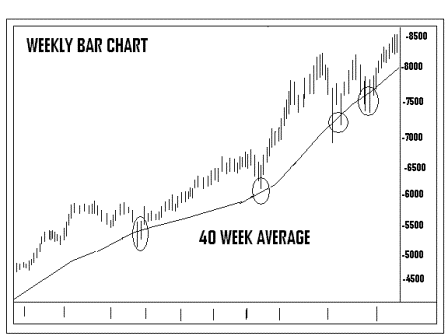There are a few things that need to be brought to light about using moving averages:
The wise stock trader or options trader knows the moving average can be used in longer-range trend analysis. Although widely used in stock market analysis, longer-range moving averages, such as 10 or 13 weeks, in conjunction with 30- or 40-week averages, are not given much attention in futures markets. The 10- and 40-week averages are very useful in tracking the primary trend on weekly charts for futures and stocks. See the rough graph below of a 40-week moving average as it provides support during bull market corrections.

One of the biggest reasons moving averages are so popular as trend-following systems is that they embody some of the oldest maxims of successful trading. They trade in the direction of the trend, and moving averages let profits run and cut losses short. These principles of the moving average force the user to obey the rules by providing specific buy and sell signals.
The biggest disadvantage in using moving averages is, since they are trend-following in nature, they work best when the markets are in a trending period. Their performance is extremely poor in choppy markets or when the market is in a sideways trend. Unfortunately, this can be a third to a half of the time. Because they do not work well for significant periods of time, it is dangerous to rely too heavily on the moving average technique. However, there are certain trending markets where the moving average can't be beat.
The double crossover method created during the use of two moving averages can construct an oscillator. One method that compares two exponentially smoothed averages is called the Moving Average Convergence/Divergence (MACD).
The moving average can be applied to many types of technical data: open interest and volume figures, on balance volume, various indicators and ratios, and oscillators.
Andy Swan is co-founder and head trader for DaytradeTeam.com. To get all of Andy's day trading, swing trading, and options trading alerts in real time, subscribe to a one-week, all-inclusive trial membership to DaytradeTeam by clicking here.